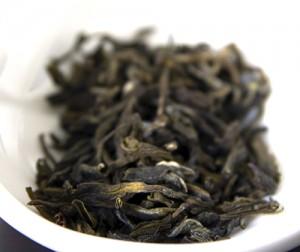When you dine at a traditional Chinese Restaurant, you are often given an assortment of choices from the soup to various dishes.
More often than not, beverage is an afterthought with the host often muttering a perfunctory “Chinese tea” to the restaurant staff before continuing to pore through the dazzling array of culinary delight.
If you would like to go beyond “Chinese tea” when it comes to ordering tea, then this post is for you.
In Singapore, with a few exceptions, generally choices don’t extend beyond 3-4 options. We will take a look at 7 of those most common ones.
1. Jasmine Tea (茉莉花茶) aka Xiangpian (香片)
What is it?

The process can be repeated anytime from 3-7 times depending on the grade and usually few if any petals are found in the tea.
Recommended for:
Unless you or your guest is allergic to jasmine flowers, jasmine tea is generally the most popular for new or non-regular tea drinkers.
In our hot weather, the green tea nature helps us to cool down in TCM nomenclature.
It is particularly recommended for saltier dishes or seafood dishes because the brisk taste helps us salivate and quench thirst.
Trivial:
The highest grade of jasmine teas are made from jasmine flowers from Fuzhou, Fujian and are harvested around July each year.
2. Puer (普洱)
What is it?
Puer that are served in most Chinese restaurants are usually “ripe Puer” or Shu Pu(熟普) or teas that undergo fermentation- in the ‘proper’ sense of the word.

Recommended for:
If you are ordering greasy, fried stuff such as Dim Sum, Puer is probably your best choice. The fermented nature coupled with its degreasing properties, makes it an excellent digestive aid. Perfect for washing down that extra har kau you wished you didn’t order.
Trivial:
Puer can be divided in Sheng (生) and Shu (熟) Puer with the former being aged naturally and the latter being an induced fermentation to emulate the former.
3. Tieguanyin (铁观音) aka Iron Goddess of Mercy
What is it?
Tieguanyin is probably the best known oolong tea in the world.

When served in Chinese restaurants, usually it is a heavy roasted traditional version that has a robust, woody taste.
Recommended for:
Tieguanyin generally goes well with spicy- particularly pepper- and meat dishes as it is a good digestive and its bittersweet flavor stands up well against stronger conflicting flavors.
Trivial:
Up till the 80s, oolong tea is seldom consumed in China outside of Guangdong and Fujian but with the marketing efforts of Anxi producers, Tieguanyin took China by storm and paved the way for other oolong teas to gain mass appeal.
4. Shuixian (水仙) aka Daffodil or Sacred Lily
What is it?

Like Tieguanyin, it is an oolong tea but it is grown in Northern Fujian- usually JianOu or Jianyang for restaurant varieties- and varies considerably in terms of production style.
Recommended for:
Shuixian helps settles the stomach and would be a good choice if your guests includes people of a more matured age group since teas like jasmine tea may cause irritation to weaker stomachs.
Like Tieguanyin, it goes well with spicy and meat dishes.
5. Shoumei (寿眉)
What is it?

(Read more about white teas here)
Recommended for:
White teas tend to be ‘cooling’ in TCM nomenclature, making it suitable for a hot day or when baked or fried foodstuffs are served.
Trivial:
Shoumei is made from the leftovers after picking Silver Needles and White Peony. In fact, part of it is made from the remnants after the buds have been extracted in the production of Silver Needles which is why Shoumei is sold at a fraction of the price of the other 2 more illustrious varieties of white tea.
6. Chrysanthemum tea (菊花茶)
What is it?

Image taken from WikiCommons
This probably needs no introduction, made from golden yellow flowers of the chrysanthemum plant (hence technically not a “tea” in the strictest sense of the word) chrysanthemum tea is commonly served where ethnic Chinese exists.
Infusions are generally bittersweet and are often sweetened with rock sugar or cane sugar.
Recommended for:
Late night dinners when caffeine consumption is not encouraged for fear of insomnia.
Trivial:
The golden flower referred in Chow Yun Fat’s Curse of the Golden Flower (满城尽带黄金甲)is chrysanthemum.
7. Babao Tea or Eight Treasures Tea (八宝茶)
What is it?

It is a favorite among Northern Chinese and can be expected to be served in Beijing cuisine restaurants.
Recommended for:
A nice refreshing drink, good for older folks with weaker digestives or colder periods as red dates especially is believed to boost ‘qi’.
A Final Note:
It has been said before here but it bears repeating that due to lower quality offerings, improper brewing techniques and lack of equipment, Chinese teas served in restaurants seldom offer the same epicurean delight as decent offerings.
Nevertheless when it is served in a restaurant, tea generally plays a secondary role to the food and that considered, it fulfills its purposes.
See here for other articles related to Singapore tea culture
